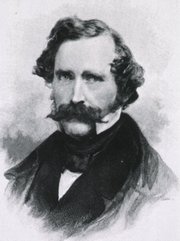This article is part of the series "A Moment in History" where we honor those who have contributed to the growth of medical knowledge in the areas of anatomy, medicine, surgery, and medical research.
When I started the sidebar segment entitled "A Moment in History", I thought that it would be only biographical articles. On January 28, 2014, traveling from Austin TX to Cincinnati I was reading a wonderful book: "Masters of the Scalpel" (1962) by Sarah R. Riedman Ph.D. In one of the chapters Dr. Riedman writes about the first use of anesthesia in Surgery. Because of the author's style, as I read the following excerpt, I found myself wondering how it would have felt to be there while history was being made:
"On the morning of October 16, 1846, all but one of the principals were ready in the amphitheatre: Dr. Warren, the senior surgeon, his assistants and strong-armed men who were to hold the patient down, the students, and other spectators were waiting; the patient was brought in, pale with fright.
There was no turning back: everything was set for the removal of the tumor on his jaw. Only Morton (Dr. William T. G. Morton) had not arrived. Dr. Warren was ready to proceed without him, announcing to the onlookers: "As Dr. Morton has not arrived, I presume he is otherwise engaged." And he was - putting the finishing touches on his inhaler in the instrument maker's shop.
Just as the skeptical audience burst into laughter at Dr. Warren's remark, Morton appeared. The operation was held up for a few minutes while Morton prepared a sponge soaked in ether which he placed in the inhaling globe, temporarily corked.
As he came forward to the operating table on which the patient was strapped as always before an operation, Dr. Warren turned to Morton, saying: "Well sir! Your patient is ready."
But Morton wished to gain the patient's confidence. Pointing to Eben Frost ( A patient from whom Dr. Morton had removed a tooth under ether) who in gratitude had come along to the hospital, he said to the pale man: "There is a man who has been operated on under this chemical, and can tell you that it worked." Frost gladly complied.
"Are you afraid?" Morton asked the patient. Whether from courage or confidence, the patient replied, "No, I will do as you tell me."
Morton then put the neck of the flask to the patient's mouth, instructing him to breathe. Slowly the patient went under, his arms and legs jerking in a way probably familiar to frequenters at "ether frolics." As yet no one suspected what the chemical was. After several minutes, the patient was asleep and relaxed. It was now Morton's cue in the drama, as he turned to Dr. Warren. "Sir, your patient is ready."
Warren made the incision. He, like the witnesses, was ready for the bloodcurdling screams so familiar in the operating room. But the patient uttered not a sound.
The operation over, the patient slowly regained consciousness. When questioned by Morton, he readily admitted having felt no pain.
Dr. Warren then broke the silence with the famous words: "Gentlemen, this is no humbug!" And Dr. Henry J. Bigelow: "I have seen something today that will be heard round the world."
The first page of a new chapter in the story of surgery was turned that day."
While looking out the airplane window to the passing cities below, I thought about the millions of people that had been affected by this "Moment in History" and that it needed to be shared and retold to the generations to follow.
The operation took place in the first operating room built at the Massachusetts General Hospital. This room has been preserved and is today known as the "Ether Dome". You can read an article on a visit I made to this historic place. Dr. Miranda
Biographical note: Sarah Regal Riedman was born on April 20, 1902 in Kishiniev, Rumania and became a U.S. citizen in 1918. In 1926, she received a bachelor's degree from Hunter College, followed by a Masters of Science degree from New York University in 1928. In 1935, Ms. Riedman received her Ph.D. from Columbia University. She taught at Hunter College from 1926 to 1930, and at Brooklyn College from 1930 to 1952. At Brooklyn College, she was an instructor, and later an assistant professor of biology.
Ms. Riedman began writing science books for children in 1947, with the publication of "How Man Discovered His Body". Between 1947 and 1983, she wrote or co- wrote approximately forty books. We have not been able to find further information on her. Any contribution to her biography will be most welcome.
Original image (public domain) courtesy of NLM





